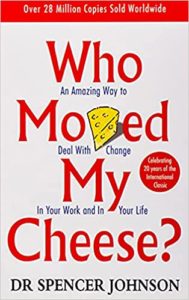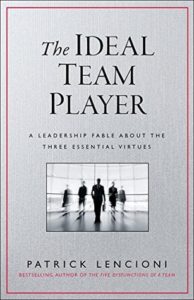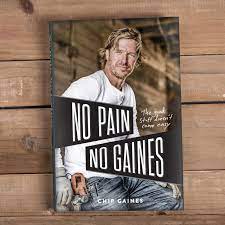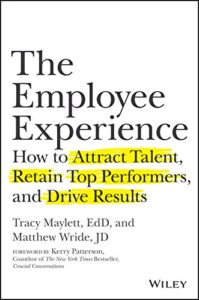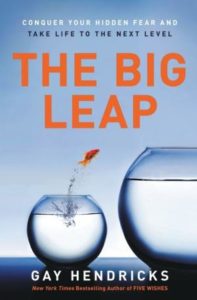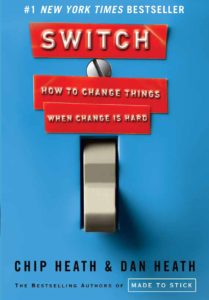Team Leap Book Club | Leap Solutions Group, Inc.
The Leap Team loves a good book or two or ten. If you peeked at our book purchases, you’ll see the diversity of our interests. We figured our newsletter readers would like to see what we have been reading and using in our work with our clients. Enjoy the first-ever (and hopefully more frequent), Team Leap Book Club selections. Reading a book is a good thing to do and with the ability to read, listen and sometimes even watch a book or story on stage or on a screen, it is time to make your next selection. Here are some of ours…
Books reviewed in this issue of our newsletter:
- Who Moved my Cheese?
- The Ideal Team Player: How to Recognize and Cultivate the Three Essential Virtues
- No Pain, No Gaines
- The Employee Experience
- The Big Leap: Conquer Your Hidden Fear
- Switch: How to Change Things When Change is Hard
- Atomic Habits
By Dr. Spencer Johnson
Publisher: Vermilion
ISBN-10: 0091816971
By Chuck McPherson ~ We all experience change in our lives. It can be distressing or rewarding, depending on our approach. “Who Moved My Cheese?” is a classic parable that demonstrates in practical terms how to better handle change and avoid pitfalls by practicing a few key principles: anticipate and prepare for change, overcome fears, envision success, and enjoy change. By depicting simple, memorable characters and scenarios, the parable gives you a framework for responding to change successfully.
Teams going through change could benefit from the easy lessons this book has to offer and guiding principles can be key discussion points for the team to work with as they go through change or prepare to go through change.
By Patrick Lencioni
Publisher: Jossey-Bass
ISBN-10:1119209591
By Tracy Emmerich ~ This is an easy and fun book to read! The first half of the book is based on a character (Jeff Shanley) who leaves the high-tech business behind to learn and eventually take over his uncle’s construction business (based on a fictional company in Napa!). Jeff has business smarts but knows nothing about construction. Jeff has been working with his uncle learning the ropes for about two months when his uncle informs him that due to health reasons, he must step away from the family business. He assures Jeff that he has faith in him to run the business. Oh, and by the way, the company just landed two large projects, they don’t have the staffing, and cash flow is short because of delays and problems on one of their projects.
The book follows Jeff and his executive team in the way they process issues they have faced, including high turnover and project delays. The team determines that successful employees all have the same “virtues” that make them strong team players (Hungry, Humble, and Smart about people). They evaluate current employees to clarify who on their team has all of these virtues; if they don’t have these virtues, can they be taught? If not, they show how to help them find a job that does not require being a team player. They also make it clear that the company embraces these virtues and if someone does not have these or is unwilling to improve on these virtues, then they will not like working for this company because it is who they are; it is their culture.
The second half of the book gives examples and suggestions on how to apply the team player virtues when hiring and evaluating current employees, how to develop an employee who is lacking in one or more virtues but most important, embedding the model into an organization’s culture.
If the culture of your organization aligns with the three virtues identified in the book – humility, hungry, and smart and you are looking to build or enhance your team with this type of team member, the book gives examples of interview questions and outlines how to evaluate and develop your team players to build the desired culture you want for your organization.
By Chip Gaines
Publisher: HarperCollins
ISBN-10: 0785237914
By Susana Morales ~ I love meeting new people and learning from them. When I go to a network event, which we all know has been a long time since that has happened, I meet people and ask about their stories. I believe networking is about building relationships that stand the test of time which is why I picked up Chip Gaines’ book on networking, No Pain, No Gaines. My interpretation of the book is that he talks about finding your purpose and charting your own path in search of your authentic self. And once you know who you are, you can create your network. A strong network, as defined by him, is a set of relationships that stand by you in the good times and especially in the bad times. There are many nuggets of cool information in the book; I chose a few that resonate with me to share with you:
- Success is not just about working hard it is more about what you are working towards.
- There will be seasons that are scary but none scarier than not living life on your own terms.
- Don’t be a comfortable connector and only hang out with the people who are exactly like you. Be a radical connector, be fearless, and be okay with the possible awkwardness of letting new people into your circle.
- Have a strong circle/network.
- The currency we should be offering one another should be vulnerability and understanding not, “What can you do for me?”
- Don’t let fear limit your potential and ask yourself what great things would come to you if fear wasn’t part of the equation.
How do you start building a strong network? Funny thing about creating your network, it’s advice which I think we all know. If you are the most driven in your network, you need a new network. If you are the strongest leader in your network, you need a new network. If you are the smartest in your network, you need a new network. You need to surround yourself with people who will challenge you to reach your full potential all of the time and every time.
By Tracy Maylett, EdD & Matthew Wride, JD
Publisher: John Wiley & Sons, Inc.
ISBN-10: 1119294184
Introduction
By Tracy Long ~ Attracting and retaining great talent has always been an issue, but even more so with the recent challenges of a post-COVID recession and trends like the “Great Resignation.” It’s not enough to have competitive pay and benefits when there are so many companies vying for a small talent pool. Organizations looking for a competitive advantage would do well to embrace the research and insights from The Employee Experience.
“A well-designed Employee Experience is about creating a better future, rather than focusing obsessively on keeping employees from becoming dissatisfied through perks, employee bonuses, and the like.”
Building upon their success with MAGIC: Five Keys to Unlock the Power of Employee Engagement, Tracy Maylett and Matthew Wride guide us through three critical components of the Employee Experience (EX):
- Expectation Alignment
- The Three Contracts
- Trust
Expectation Alignment
Disengagement (and turnover) results from unclear or unmet expectations and, according to Maylett and Wride, this misalignment increases over time unless the gap between what an employee has been promised and what the employee thinks has been promised has been identified and aligned.
“In the absence of clearly defined expectations, we find or create expectations to fill the void.”
The book explores the symptoms and causes of expectation alignment dysfunction and offers five proven preventative measures and a framework to improve the misalignment.
The Three Contracts
Contracts are the implicit and explicit expectations between relationships. The Employee Experience takes this further by diving into the subcontracts of the Brand Contract, the Transactional Contract and the Psychological Contract and looks at warning signs that the contract is in jeopardy.
Simply stated, the brand contract is your public face and is made up of all the implied promises of your brand messaging. This message helps attract candidates. The transactional contract is an explicit agreement about the terms of the relationship which can be written or verbal. The psychological contract underscores the unstated expectations and beliefs in a relationship and has the most potential to affect the EX. In the absence of clear messaging and alignment in the first two contracts, employees assume the psychological contract rules. When it is violated, employees disengage.
Trust
According to Maylett and Wride, when a “Moment of Truth” happens (something that tests the validity of the contracts) employees will learn whether their employer/supervisor keeps their promises or not. The reward for increased trust is agility; a prized quality in any organization.
This book provides clear, real-world organizational stories and research to highlight the lessons which makes it very relatable and easy to read. In working with managers, I find that unclear or misaligned expectations are the root of many employee relations issues. This book provides managers with tools to understand the connection between expectation alignment and employee engagement, to identify and correct violations of the three contracts, and to build trust so that employees have a meaningful experience, which in turn, creates high-performing, loyal, mission driven employees. I highly recommend it for all managers.
By Gay Hendricks, Ph.D.
Publisher: HarperCollins
ISBN-10: 100061735363
By Jen Chelini ~ Gay Hendricks speaks to the ultimate life roadblock – the “Upper Limit Problem”, a negative emotional reaction that occurs when anything positive enters our lives, not only preventing happiness but stopping us from achieving our goals. Gay Hendricks addresses this problem through a simple program that identifies four fears that prevent us from reaching our upper limit, guides us in learning a new set of powerful skills and habits, and eventually frees us to reach our true potential. Hear from rock stars to Fortune 500 executives who identify their fears and break through their limitations to achieve their true greatness and enjoy financial, love and life successes.
By Chip Heath & Dan Heath
Publisher: Crown Business
ISBN-10: 0385528757
By Scott Ormerod ~ Built on the concept of a Rider, Elephant, and Path, the Heath brothers bring to light how individuals manage change through their rational side (The Rider), their emotional side (The Elephant), and their journey to change (The Path). Our rational side helps us to find the bright spots within ourselves and our work life, it shows us how to script our critical moves, and it points us to the destination where we want to head in the near-future. When our emotional side is engaged, we will find the feeling of the change, shrink the change to make it manageable, and grow our people to be part of the change. Finally, with the path side of change, we can tweak the environment, build habits to support the change, and form systems and processes to keep the change going. With each element of the change model, the authors delight the reader with relevant stories and the outcomes individuals and organizations have experienced as they walk through the change model.
This book is a wonderful tool to help your organization and yourself understand change AND it also helps you create the path for successful change. The approach and applications can fit any organization and serve as an inspiration during a change experience.
Another aspect that I particularly appreciate is the many tools the Heath brothers have developed to support the reader and teams to implement the change model. Their website resources page (click here) contains downloadable tools that you will appreciate and use.
Personally, I have used this book many times to support our clients as they navigate the path of change. Read it and see how you can affect change in yourself and your organization.
By James Clear
Publisher: Penguin Random House
ISBN-10: 0735211299
By Judy Coffey ~ When working with clients many will acknowledge their less-than-ideal habits, and how difficult it is to change the routine. According to the author, individuals do not rise to the level of their intended goals, not because they don’t want to change, but because they have the wrong system for change.
An atomic habit or routine is small and easy to accomplish. The change you make might seem unimportant at the time, but if you are willing to stick to the simple changes, one can see remarkable results going forward.
For example, one individual was unable to focus the team on financial performance, their goals were not aligned and meetings were spent arguing whose program would need to be eliminated or changed. According to the book, it is a simple two-step process: decide what type of leader you want to be, make small changes and prove to yourself a win. This individual built better habits around meetings, agendas and ultimate outcomes.
The book discusses:
- An atomic habit is easy and an incredible source of power
- Bad habits repeat themselves again and again
- Changes made to habits will compound into remarkable results
Five Big Ideas for better results:
- Habits are the compound of self -improvement
- If you want better results focus on your systems
- The most effective way to change your habits is to focus on what you want to become
- Understand the Four Laws of Behavior: make it obvious, make it attractive, make it easy, and make it satisfying
- Environment is the invisible hand that shapes human behavior
Atomic Habits will help reshape the way you think; gradually your habits become associated with the entire context surrounding the behavior and the context becomes the “cue”. Whether you are an athlete looking to win a championship, a leader hoping to achieve maximum efficiency within your organization, or an individual looking to reduce or eliminate bad habits, this book will give you tools and techniques to support transforming your habits.
***
Leap Solutions is a diverse group of highly skilled management, organizational development, and human resources, and executive search and recruitment professionals who have spent decades doing what we feel passionate about helping you feel passionate about what you do. Our HR specialists can help you get a handle on the ever-changing COVID-19 guidelines, programs, and legislation that may impact you and your employees. We are available to work with you to develop practical solutions and smart planning decisions for your organization’s immediate, near, and long-term needs.
To print this article, click here

![]()
